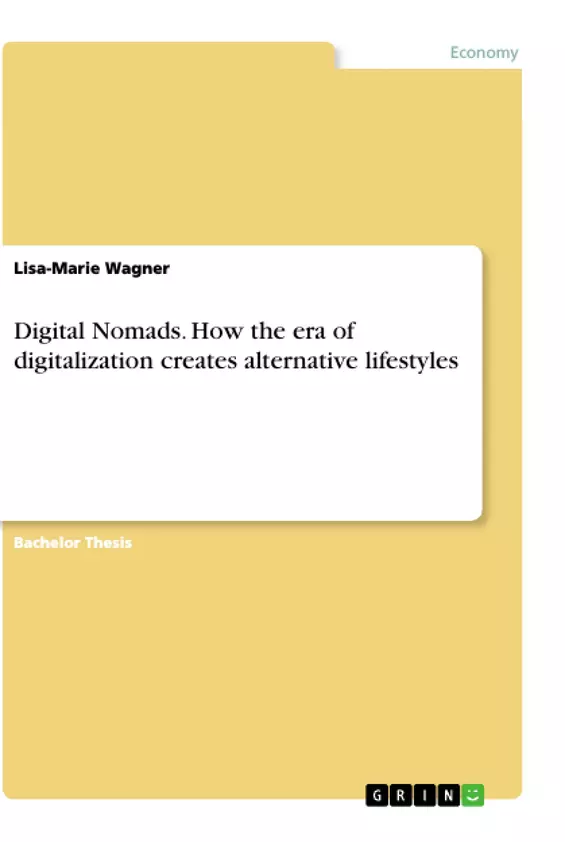In this paper, the phenomenon of digital nomadism in permanent employment is presented. In general, digital nomads are characterized by their independence of location, their employment in the digital space and common values. Most of them are freelancers and entrepreneurs, but also employees, who are part of this movement, want to leave the conservative concept of normal employment and break new ground. First the changes in the business world and the emergence of digital nomadism were presented in this paper.
Due to a lack of literature, guideline-based expert interviews were conducted to gain insight into the opportunities and risks of the multi-local lifestyle concept for employees and companies. In addition, the framework conditions for companies and digital nomads required by this work and life concept were examined and presented in detail. Such a framework condition can mean, for example, the adaptation of processes and leadership. There are also differences between completely remote companies and only partially remote companies, which can lead to a split company structure. In this context, the similarities and differences between traditional telework and digital nomadism in permanent employment were also examined.
These are similar, for example, regarding the technical prerequisites that should be created in companies and the changed communication. In addition, there are challenges and opportunities that arise from the travel component and the nature of digital nomadism, such as negatively impaired processes due to time differences or certain characteristics and experiences that digital nomads possess or experience that can be used positively in a professional context. Thus, this work not only serves a scientific purpose, but also provides a practical framework for employing digital nomads in traditional companies.
Inhaltsverzeichnis (Table of Contents)
- Introduction
- Background and relevance
- Approach and structure of this thesis
- Current state of research
- Objective target and research questions
- Definition and delimitation of terms
- Delimitation to Teleworking, Home office und Remote Work
- Coworking
- Development and concept of digital nomadism in permanent employment
- Definition and characteristics
- Structural change in the business world
- Emergence of digital nomadism
- Current situation: Advantages and disadvantages in the permanent employment of digital nomads
- Method
- Choice and relevance of the method
- Development of the questionnaire
- Selection of interviewees
- Data collection and data analysis
- Reflection of the methods used
- Results
- Advantages and opportunities
- Disadvantages and risks
- Framework conditions and possible solution strategies
- Future strategies for companies and digital nomads
Zielsetzung und Themenschwerpunkte (Objectives and Key Themes)
This thesis examines the phenomenon of digital nomadism in permanent employment. It delves into the characteristics, opportunities, and risks associated with this lifestyle, specifically focusing on the implications for both employees and companies. The research utilizes expert interviews to provide a deeper understanding of the challenges and benefits presented by this evolving work and life concept.
- The emergence and development of digital nomadism in the context of a changing business world
- The opportunities and risks associated with digital nomadism for both employees and companies
- The framework conditions and solution strategies necessary for successful integration of digital nomads within traditional companies
- The similarities and differences between digital nomadism and traditional telework
- The impact of digital nomadism on company structures and communication
Zusammenfassung der Kapitel (Chapter Summaries)
The introduction provides context by outlining the background and relevance of digital nomadism, the thesis's approach and structure, and the current state of research. It also presents the research questions that will guide the investigation.
Chapter 2 defines and clarifies key terms related to digital nomadism, drawing distinctions between related concepts such as teleworking, home office, remote work, and coworking.
Chapter 3 dives into the development and concept of digital nomadism in permanent employment, examining its characteristics, the changing landscape of the business world, and the emergence of this lifestyle. It also analyzes the current advantages and disadvantages of digital nomadism for both employees and companies.
Chapter 4 outlines the methodology employed in the research, including the rationale for the chosen method, the questionnaire development process, the selection of interviewees, the data collection and analysis techniques, and a reflection on the methods used.
Chapter 5 presents the findings of the research, highlighting the advantages and opportunities associated with digital nomadism, as well as the disadvantages and risks. It also explores potential framework conditions and solution strategies for integrating digital nomads within traditional companies.
Chapter 6 delves into future strategies for both companies and digital nomads, considering the evolving landscape of this work and life concept.
Schlüsselwörter (Keywords)
Digital nomadism, permanent employment, remote work, telework, coworking, business world, opportunities, risks, framework conditions, solution strategies, company structure, communication, future strategies, lifestyle, work environment, expert interviews, research methods, data analysis.
- Quote paper
- Lisa-Marie Wagner (Author), 2020, Digital Nomads. How the era of digitalization creates alternative lifestyles, Munich, GRIN Verlag, https://www.grin.com/document/542511



